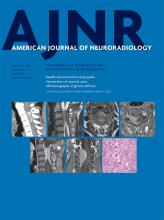Research ArticleAdult Brain
Do Fluid-Attenuated Inversion Recovery Vascular Hyperintensities Represent Good Collaterals before Reperfusion Therapy?
E. Mahdjoub, G. Turc, L. Legrand, J. Benzakoun, M. Edjlali, P. Seners, S. Charron, W. Ben Hassen, O. Naggara, J.-F. Meder, J.-L. Mas, J.-C. Baron and C. Oppenheim
American Journal of Neuroradiology January 2018, 39 (1) 77-83; DOI: https://doi.org/10.3174/ajnr.A5431
E. Mahdjoub
aFrom the Departments of Radiology (E.M., L.L., J.B., M.E., S.C., W.B.H., O.N., J.-F.M., C.O.)
G. Turc
bNeurology (G.T., P.S., J.-L.M., J.-C.B.), Université Paris Descartes, Institut national de la santé et de la recherche médicale S894, Département Hospitalo-Universitaire Neurovasc, Centre Hospitalier Sainte-Anne, Paris, France.
L. Legrand
aFrom the Departments of Radiology (E.M., L.L., J.B., M.E., S.C., W.B.H., O.N., J.-F.M., C.O.)
J. Benzakoun
aFrom the Departments of Radiology (E.M., L.L., J.B., M.E., S.C., W.B.H., O.N., J.-F.M., C.O.)
M. Edjlali
aFrom the Departments of Radiology (E.M., L.L., J.B., M.E., S.C., W.B.H., O.N., J.-F.M., C.O.)
P. Seners
bNeurology (G.T., P.S., J.-L.M., J.-C.B.), Université Paris Descartes, Institut national de la santé et de la recherche médicale S894, Département Hospitalo-Universitaire Neurovasc, Centre Hospitalier Sainte-Anne, Paris, France.
S. Charron
aFrom the Departments of Radiology (E.M., L.L., J.B., M.E., S.C., W.B.H., O.N., J.-F.M., C.O.)
W. Ben Hassen
aFrom the Departments of Radiology (E.M., L.L., J.B., M.E., S.C., W.B.H., O.N., J.-F.M., C.O.)
O. Naggara
aFrom the Departments of Radiology (E.M., L.L., J.B., M.E., S.C., W.B.H., O.N., J.-F.M., C.O.)
J.-F. Meder
aFrom the Departments of Radiology (E.M., L.L., J.B., M.E., S.C., W.B.H., O.N., J.-F.M., C.O.)
J.-L. Mas
bNeurology (G.T., P.S., J.-L.M., J.-C.B.), Université Paris Descartes, Institut national de la santé et de la recherche médicale S894, Département Hospitalo-Universitaire Neurovasc, Centre Hospitalier Sainte-Anne, Paris, France.
J.-C. Baron
bNeurology (G.T., P.S., J.-L.M., J.-C.B.), Université Paris Descartes, Institut national de la santé et de la recherche médicale S894, Département Hospitalo-Universitaire Neurovasc, Centre Hospitalier Sainte-Anne, Paris, France.
C. Oppenheim
aFrom the Departments of Radiology (E.M., L.L., J.B., M.E., S.C., W.B.H., O.N., J.-F.M., C.O.)

References
- 1.↵
- McVerry F,
- Liebeskind DS,
- Muir KW
- 2.↵
- 3.↵
- 4.↵
- 5.↵
- Bang OY,
- Saver JL,
- Alger JR, et al
- 6.↵
- Olivot JM,
- Mlynash M,
- Inoue M, et al
- 7.↵
- Kamran S,
- Bates V,
- Bakshi R, et al
- 8.↵
- Azizyan A,
- Sanossian N,
- Mogensen MA, et al
- 9.↵
- Legrand L,
- Tisserand M,
- Turc G, et al
- 10.↵
- Sanossian N,
- Saver JL,
- Alger JR, et al
- 11.↵
- 12.↵
- Kufner A,
- Galinovic I,
- Ambrosi V, et al
- 13.↵
- Ebinger M,
- Kufner A,
- Galinovic I, et al
- 14.↵
- 15.↵
- 16.↵
- Lee KY,
- Latour LL,
- Luby M, et al
- 17.↵
- Liu D,
- Scalzo F,
- Rao NM, et al
- 18.↵
- 19.↵
- 20.↵
- Legrand L,
- Tisserand M,
- Turc G, et al
- 21.↵
- 22.↵
- Wouters A,
- Dupont P,
- Christensen S, et al
- 23.↵
- Cheng B,
- Ebinger M,
- Kufner A, et al
- 24.↵
- 25.↵
- Schellinger PD,
- Chalela JA,
- Kang DW, et al
- 26.↵
- 27.↵
- 28.↵
In this issue
American Journal of Neuroradiology
Vol. 39, Issue 1
1 Jan 2018
Advertisement
E. Mahdjoub, G. Turc, L. Legrand, J. Benzakoun, M. Edjlali, P. Seners, S. Charron, W. Ben Hassen, O. Naggara, J.-F. Meder, J.-L. Mas, J.-C. Baron, C. Oppenheim
Do Fluid-Attenuated Inversion Recovery Vascular Hyperintensities Represent Good Collaterals before Reperfusion Therapy?
American Journal of Neuroradiology Jan 2018, 39 (1) 77-83; DOI: 10.3174/ajnr.A5431
0 Responses
Do Fluid-Attenuated Inversion Recovery Vascular Hyperintensities Represent Good Collaterals before Reperfusion Therapy?
E. Mahdjoub, G. Turc, L. Legrand, J. Benzakoun, M. Edjlali, P. Seners, S. Charron, W. Ben Hassen, O. Naggara, J.-F. Meder, J.-L. Mas, J.-C. Baron, C. Oppenheim
American Journal of Neuroradiology Jan 2018, 39 (1) 77-83; DOI: 10.3174/ajnr.A5431
Jump to section
Related Articles
Cited By...
- New insights on the predictive value of hypoperfusion intensity ratio in thrombectomy: an updated systematic review and meta-analysis with multiple cut-offs
- Persistent perfusion abnormalities at day 1 correspond to different clinical trajectories after stroke
- Association of fluid-attenuated inversion recovery vascular hyperintensity with ischaemic events in internal carotid artery or middle cerebral artery occlusion
- FLAIR Vascular Hyperintensities as a Surrogate of Collaterals in Acute Stroke: DWI Matters
- Association between fluid-attenuated inversion recovery vascular hyperintensity and outcome varies with different lesion patterns in patients with intravenous thrombolysis
- Clinical prognosis of FLAIR hyperintense arteries in ischaemic stroke patients: a systematic review and meta-analysis
- The Association between FLAIR Vascular Hyperintensity and Stroke Outcome Varies with Time from Onset
This article has not yet been cited by articles in journals that are participating in Crossref Cited-by Linking.
More in this TOC Section
Similar Articles
Advertisement











